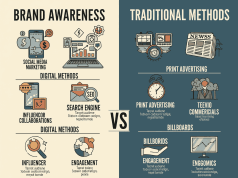In today’s fast-paced digital landscape, brands are confronted with unprecedented competition and consumer fatigue. As organizations seek to capture the attention of their target audience, merely maintaining visibility is not enough. Businesses must innovate and employ strategic methods to elevate their brand awareness and unlock their potential. Here, we explore innovative strategies that can help brands rise above the noise in a crowded market.
1. Leverage Authentic Storytelling
Consumers are increasingly drawn to brands that tell compelling stories. Authenticity resonates more than slick advertising messages. Brands should focus on weaving their values, mission, and unique narratives into engaging content. By sharing real customer experiences or highlighting the origins of their products, companies can create emotional connections with their audience. Use multimedia approaches—videos, podcasts, or Instagram stories—to bring these narratives to life.
Example:
Patagonia excels in this area by sharing stories about environmental protection, reflecting their commitment to sustainability. This promotes brand loyalty and attracts like-minded consumers.
2. Harness the Power of Influencer Marketing
Influencer marketing continues to gain traction as brands seek more relatable ambassadors. Collaborating with micro and nano influencers can yield high engagement rates and foster trust. Brands should look for influencers whose values align with their own and who have a genuine connection with their audience.
Strategy:
Develop partnerships that allow influencers to showcase the product in a natural, engaging manner. This could involve product placements in their content or co-creating offerings that resonate with their followers.
3. Embrace Personalization and Segmentation
In a world saturated with generic marketing messages, personalization is key. By leveraging data analytics and customer insights, brands can tailor their messaging to meet the needs and preferences of individual segments. Personalized email campaigns, targeted social media ads, and customized website experiences can significantly enhance brand visibility and recall.
Implementation:
Utilize customer relationship management (CRM) tools and marketing automation to segment your audience and deliver targeted content consistently.
4. Invest in Experiential Marketing
Creating immersive experiences allows brands to engage and connect with their audience on a deeper level. Experiential marketing initiatives—such as pop-up events, workshops, or interactive installations—enable consumers to interact with the brand in meaningful ways.
Example:
IKEA’s “IKEA Place” app allows customers to visualize furniture in their own homes using augmented reality, enhancing their shopping experience and fostering brand loyalty.
5. Utilize User-Generated Content (UGC)
Encouraging customers to create and share content related to the brand can amplify awareness organically. UGC not only serves as authentic promotional material but also fosters a sense of community among customers. Brands can create campaigns where they invite customers to share their experiences using specific hashtags or themes.
Strategy:
Highlight the best submissions on brand channels to incentivize participation and create buzz.
6. Optimize for Search and Voice
As consumers increasingly turn to search engines and voice-activated devices to find services and products, optimizing online presence is critical. Employ search engine optimization (SEO) strategies tailored to voice search to ensure visibility in search results.
Action Steps:
Focus on long-tail keywords and natural language phrases that reflect how consumers inquire about products, ensuring your brand appears in relevant searches.
7. Engage in Social Causes
Aligning with social causes allows brands to resonate with socially conscious consumers. Brands can create campaigns that support or advocate for causes that matter to their audience, thus forming a more profound connection with them.
Execution:
Consider partnerships with non-profits or organizing community initiatives that reflect brand values, showcasing your commitment to societal betterment.
8. Use Data Analytics for Continuous Improvement
Finally, incorporating data analytics into brand strategy can help track effectiveness and inform future endeavors. Brands should regularly assess the performance of their awareness initiatives and adjust strategies accordingly.
Implementation:
Set measurable goals, whether it be engagement rates, conversion rates, or brand perception metrics, to evaluate success effectively.
Conclusion
In a crowded marketplace, merely existing is no longer sufficient for brands aiming to stand out. By employing innovative strategies such as authentic storytelling, influencer partnerships, personalization, experiential marketing, and data-driven decisions, brands can elevate their awareness and unlock their full potential. As consumer expectations evolve, staying ahead of the curve and adapting to changing dynamics will be key to long-term success. Brands that can resonate meaningfully with their audience will not only elevate their awareness but will also cultivate loyal customer relationships, ensuring sustained growth and relevance in their respective markets.









